Complaints in bacterial vaginosis, trichomoniasis and vaginal yeast infection are sometimes similar. Therefore, in order to make an accurate diagnosis and undertake the correct treatment, a laboratory examination of vaginal discharge is carried out and only after the cause of the infection has been established, the appropriate medications are prescribed by a specialist. A distinctive sign of a vaginal fungal infection is the presence of white particles in the vaginal secretion or a change in its appearance in general – it acquires a denser white color, its consistency resembles curdled milk or cottage cheese. However, this sign is not always present. Other specific symptoms of vaginal yeast infection are itching, redness and swelling of the skin and mucous membranes of the genitals, burning, stinging when urinating, unpleasant irritating sensations during and after sex, change in the smell of secretions. Usually, complaints intensify a week before the date of the expected menstruation. After menstrual bleeding, it is much more likely to experience only vaginal dryness, itching, burning during urination and sex… Vaginal yeast infection in most cases is caused by the fungus Candida albicans. It is part of the natural vaginal microflora in some women. In a small amount, it does not bring complaints. Its growth is inhibited by the activity of another member of the local microflora – Lactobacillus acidophilus. The cause of the fungal infection is rather internal to the body and is due to weakened immunity, which led to an imbalance in the composition of the microorganisms that make up the vaginal microflora. Such a change in women is observed, in addition to contamination of the vagina, with another sexual infection, but also after vacation at sea, diet, stress… In principle, any illness can have a negative effect and cause an imbalance of the vaginal microflora and growth of fungi. Antibiotics are especially predisposing to this, which is why doctors today almost always prescribe medications to suppress them in this type of treatment. Elevated levels of estrogen – the female sex hormone – are also associated with higher candida activity. This goes some way to explaining why pregnant women tend to develop yeast infections, as do women on hormone replacement therapy or taking certain contraceptives. Fungal infections are also common in diabetes and high blood sugar. With more than 4 vaginal infections per year, it is advisable to seek a good specialist to clarify the presence of another health problem for them. NEWS_MORE_BOX Vaginal yeast infection is treated with antifungal agents. At the discretion of the obstetrician-gynecologist and according to the case, globules, cream, orally tablets may be prescribed. Treatment depends a lot on the number of microorganisms, the accompanying infections, as well as the frequency of vaginal yeast infections, in addition to the strength of the symptoms. Therapy for expectant mothers is specific,it is applied only at a certain period of pregnancy – usually after the first trimester and before term in order to protect the baby from infection at birth, preferring local means. In addition to cream, it is also possible to apply medication in the vagina (special globules, cream), but they are strictly defined, not so aggressive and do not pose a risk to pregnancy. During the treatment of vaginal yeast infection, it is desirable to avoid sexual contact. Not only to facilitate the recovery process and prevent the transmission of harmful microorganisms sexually, but also because vaginal medications harm the integrity of the condom, in which case the risk of unwanted pregnancy remains. Vaginal yeast infection care includes the use of neutral, unscented intimate gels and wearing cotton underwear. It is desirable to avoid tight clothing in the lower half of the body, which increases the temperature and moisture in the groin. It is important not to let the wet swimsuit dry on the body after contact with water, and to change sanitary napkins and tampons at shorter intervals.


Leave a Reply